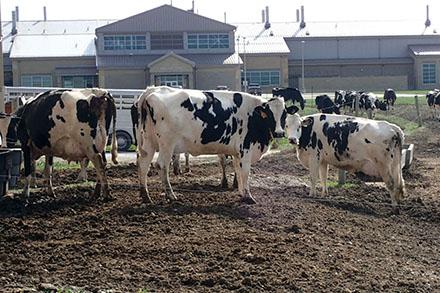Eradicating Bovine Tuberculosis From Cattle

Cattle in a feedlot. (Photo by Jim Fosse, APHIS)
Bovine tuberculosis (bTB) is a serious bacterial disease caused by Mycobacterium bovis, a bacteria that infects the respiratory system of animals. Bovine TB is primarily spread from animal to animal via respiratory secretions, but it can also be spread by ingestion of contaminated food. TB is classified into three types: human, often caused by Mycobacterium tuberculosis; avian, caused by Mycobacterium avium; and Bovine, caused by Mycobacterium bovis (M. bovis). Although cattle are the most common host of M. bovis, most mammals, including humans can be infected.
In terms of symptoms for animals like cattle and white-tailed deer that contract Bovine TB, it is often difficult to notice any clinical signs, and a person may not even realize that an animal is infected.
“We care about Bovine TB because it's a disease that can be transmitted to humans and cattle,” said Mitchell Palmer, researcher veterinary medical officer at the National Animal Disease Center (NADC) in Ames, IA. “We care about it because a state that has infected cattle can't usually ship those cattle to another state, and other countries certainly won't accept them, so it impacts our export market.”
Due to both animal and public health concerns, USDA initiated The National Tuberculosis Eradication Program in 1917. After more than a century, however, Bovine TB has not been eradicated from the U.S. cattle population, and it continues to negatively affect domestic and foreign trade.
Though the prevalence of Bovine TB has significantly decreased since the inception of the program, several obstacles have prevented Bovine TB eradication. For one, diagnostic tests lack the sensitivity needed to remove all infected animals from a herd. In addition, changes in the dairy industry have resulted in “megaherds” of 10,000 to 20,000 cows, making depopulation following a confirmed positive detection (the preferred method of disposition) non-feasible. Lastly, the presence of TB in wild white-tailed deer is persistent in certain regions and may spill over to cattle. One way this happens is when infected deer enter cattle feeding areas and contaminate cattle feed.
“We are working with USDA partners, the Animal and Plant Health Inspection Service (APHIS) on diagnostic tests with greater sensitivity and specificity, which would allow removal of infected animals and provide confidence that only non-infected cattle remain in the herd,” said Palmer. This specific technology would be especially useful in megaherds.
“Additionally, we are investigating the possible use of vaccines in cattle to prevent cow-to-cow transmission,” said Palmer. “In collaboration with APHIS Wildlife Services and Michigan State University, we are investigating the efficacy of the human TB vaccine (BCG) in deer. We have demonstrated the efficacy of orally delivered BCG in white-tailed deer and are testing prototypes of possible forms of BCG that could be included in a bait, which could be delivered to wild deer.”
Testing and removing infected cattle is one alternative to whole herd depopulation. In such a scenario the herd is tested every 6 months, and any infected cattle are removed. The herd must test negative three times in a row to be considered safe. Existing tests for Bovine TB are not 100% accurate. As such, infected cattle may be missed and remain in the herd, spreading disease to other cattle.
These cattle may be identified in subsequent tests, but early infections may be missed. It is unclear why, but some infected animals test negative over a long period of time, only to be found once disease has become more advanced. Therefore, some herds test negative twice in a row, with an infected animal identified on the third test. When this happens, the process must start over. During this period of test and removal, the herd is under quarantine, with no animals entering or leaving. All milk produced must be pasteurized, a process that kills M. bovis making the milk safe for consumers.
“A diagnostic test that allows removal of all infected cows will decrease costs to producers, both financial and personal, compared to depopulation of entire herds as a means of disease control,” said Palmer. “The use of a vaccine in wild deer will decrease deer-to-deer and deer-to-cattle transmission of the disease, reducing the number of positive cattle herds.”— By Andrew Casas, ARS Office of Communications
Also in our series on cattle:

